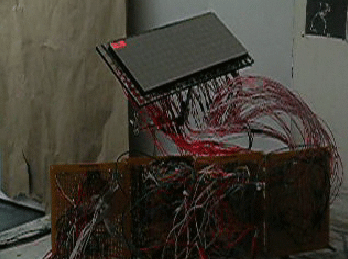
"There is a certain beauty in trying to fulfill the potential of the obsolete. As we have become a culture that is defined by the latest and greatest, and at the same time built in obsoleteness. Why are we in such a hurry to progress when we haven't realized the potential of what we have, where is this thing called progress taking us?"
This anxious quandary, posed by artist Mike Beradino, elucidates the concept behind his use of outmoded technologies. The New York-based artist has created several works that reflect upon the rapid consumption of technology, where a piece of software or hardware is embraced one moment and tossed out the very next. His lo-fi, 8X18 LED grid pieces, Liquid Pixels (2007) and blinken (2007), for example, employ the spirit of DIY, tinkering and the open source movement as a foil to an increasingly dense technological mediation within and throughout daily life. Liquid Pixels uses the LED display to create morphing patterns of ferrofluid, while blinken narrates a perverse, LED animation of a character free falling from a roof as clocks spin out of control. Beradino was inspired to create these LED pieces by the techno-primitive genre of "flashing/sparkling/blinking" art known as "Blinken" which, in 2001, emerged out of the German hacker community, Chaos Computer Club, who continue to remain active today via the BlinkenArea portal. The BlinkenArea hackers have developed a Blinken-centric operating system (BlinkOS), their own programming language (ARCADEmini Assembler), software for Blinken programs and animations, and a far-reaching manifesto for its role in "world domination," which includes an entertaining set of bullet points for achieving said domination. This auto-obsolescence as practiced by Beradino and the Blinken hackers may employ tongue-in-cheek rhetoric, but it could also be seen as an increasingly viable strategy of dissidence. - Gene McHugh

